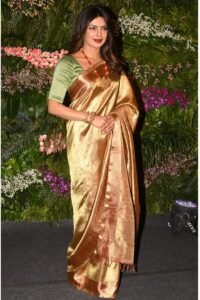Bollywood, the heart of Indian cinema, has always been a significant trendsetter in various facets of Indian culture, and fashion is no exception. Among the myriad of styles that Bollywood has popularized, the saree holds a special place. This timeless garment, draped in myriad ways and adorned with intricate designs, has been a staple in Indian fashion for centuries. However, it is through Bollywood that the saree has witnessed its most dynamic evolution, transforming from traditional attire to a symbol of glamour and sophistication. This article delves into the evolution and influence of Bollywood saree fashion, tracing its journey through different eras of Indian cinema.
The Golden Era: 1950s and 1960s
The 1950s and 1960s, often referred to as the golden era of Bollywood, were marked by classic and elegant fashion. Actresses like Nargis, Madhubala, and Meena Kumari epitomized grace in their sarees. The sarees of this era were characterized by their simplicity and sophistication. Often made from fabrics like silk and chiffon, they featured delicate embroideries and subtle prints. The saree styles from movies like “Mughal-e-Azam” and “Mother India” became iconic, with their traditional drapes and understated elegance setting a benchmark for bollywood saree fashion.

The Revolutionary 1970s
The 1970s brought a wave of change, not just in cinema but in fashion as well. Bollywood saw the emergence of more vibrant and bold saree designs, reflecting the changing social dynamics. Actresses like Zeenat Aman and Parveen Babi broke away from the traditional mould, introducing contemporary and daring styles. The chiffon sarees worn by Mumtaz in “Brahmachari” with their slim pleats and high neck blouses became a rage. This era also saw the incorporation of bold prints, polka dots, and bright colors, making the saree a symbol of youthful exuberance.
The Glamorous 1980s
The 1980s continued the trend of experimentation with saree fashion. This decade saw the rise of disco culture, which heavily influenced Bollywood fashion. Actresses like Sridevi and Rekha brought a new level of glamour to sarees. Sridevi’s iconic blue saree in the song “Kaate Nahi Kat Te” from “Mr. India” became legendary. The 1980s were also marked by the use of metallic fabrics, sequins, and bold colors. Rekha, with her penchant for kanjeevaram sarees, brought traditional weaves into the mainstream, creating a blend of classic and contemporary styles.
The Trendsetting 1990s
The 1990s were a transformative period for Bollywood saree fashion. This decade saw the amalgamation of traditional and modern styles, with designers playing a crucial role in shaping trends. Manish Malhotra, one of Bollywood’s most celebrated designers, revolutionized saree fashion with his glamorous and innovative designs. The chiffon sarees worn by Madhuri Dixit in “Hum Aapke Hain Koun” and the sensuous sarees donned by Kajol in “Dilwale Dulhania Le Jayenge” set new fashion standards. The 1990s also popularized the concept of designer blouses, with backless and halter neck designs becoming a staple in Bollywood saree fashion.

The New Millennium: 2000s
The turn of the millennium brought with it a more global and eclectic approach to saree fashion. Bollywood began to embrace international fashion trends, blending them seamlessly with traditional Indian aesthetics. Actresses like Aishwarya Rai, Priyanka Chopra, and Deepika Padukone became global fashion icons, showcasing sarees on international platforms. The sarees of the 2000s were characterized by their versatility, with designers experimenting with fabrics like net, georgette, and lace. Embellishments became more elaborate, with heavy embroidery, sequins, and crystals becoming commonplace.
The Contemporary Era: 2010s and Beyond
The 2010s and beyond have seen a resurgence of traditional handlooms and weaves in Bollywood saree fashion. There has been a significant shift towards sustainable and ethical fashion, with actresses like Vidya Balan and Sonam Kapoor championing traditional handwoven sarees. Vidya Balan’s love for silk sarees and Sonam Kapoor’s eclectic saree styles have brought a renewed interest in Indian textiles and crafts. This era also witnessed the fusion of western and Indian elements, with saree gowns and pre-stitched sarees becoming popular choices for red carpet events.
Influence on Indian Fashion
Bollywood’s influence on saree fashion extends beyond the silver screen. It shapes the sartorial choices of millions of Indian women, dictating trends for weddings, festivals, and other celebrations. The saree styles popularized by Bollywood stars often find their way into the collections of fashion designers and the wardrobes of everyday women. Whether it’s the graceful kanjeevaram sarees, the glamorous chiffon drapes, or the innovative designer creations, Bollywood continues to redefine and celebrate the saree in myriad ways.
Conclusion
The journey of the saree in Bollywood is a testament to its timeless appeal and versatility. From the classic elegance of the 1950s to the contemporary fusion styles of today, Bollywood has continually reinvented the saree, keeping it relevant and fashionable. As Indian cinema continues to evolve, one can only anticipate how Bollywood will further influence saree fashion, continuing its legacy as a trendsetter in the world of Indian fashion. The saree, with its rich cultural heritage and endless adaptability, will undoubtedly remain a beloved and iconic garment, celebrated both in Bollywood and beyond.



